There were a couple of request and some questions in the forum {including pm}, about my aviary setup etc.
It would be better if I post photos of the aviary than to try and describe it.
The photos sequence will walk the viewer from the garden at the side of my house leading to the aviary at the rear half of the house. I am not sure how important it is, but I guess a richly planted environment plays a role.
I designed and landscaped the side garden to include a winding stream leading to a pond. There is a small waterfall at the pond. I planted Heliconias and Malvavisia along the stream which attracts sunbirds as well mata putehs. The idea is to provide the sights and sounds of a natural environment.
Initially I designed the aviary to be built over the stream but later decided against it due to:
i) Impractical for any maintenance work
ii) Lack of natural shade
ii) Lack of aesthetics if viewed from the dining room
Generally most of the plants are still immature, as I had just moved into the house six months ago. I started the landscaping and planting a week after moving in and
its still in progress.
The photos:
1) View from side garden-looking towards the aviary. The stream is in the foreground and it meanders to the back.

2) View towards side garden - I stood next to the aviary to get this shot. The pond is in the foreground.
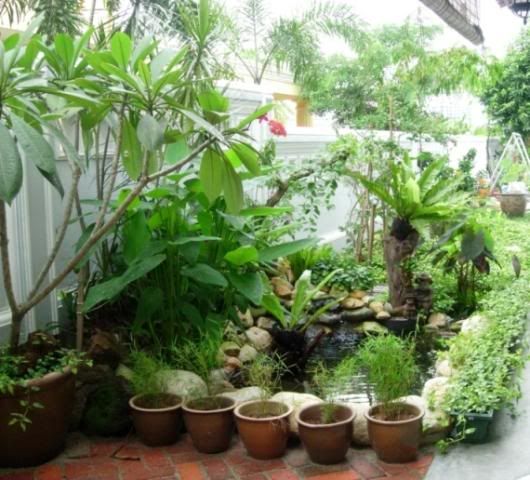
3) Overview of the Aviary - I stood next to the pond to get this shot. The 2 potted Raphis Palm (common name is Monkey Palm) is to provide shade over the area not covered by the crown of the Nangka tree and it also adds to the planted environment. Aesthetically it softens the straight severe lines of the aviary structure.
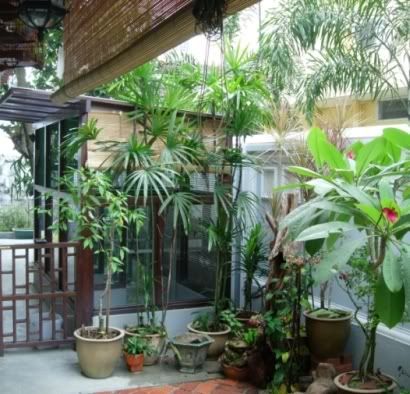
4) Closer View of the Aviary from the pond. The small plant in the foreground is an immature Kenanga, a tree with fragrant yellow blossoms, just for aesthetic value.
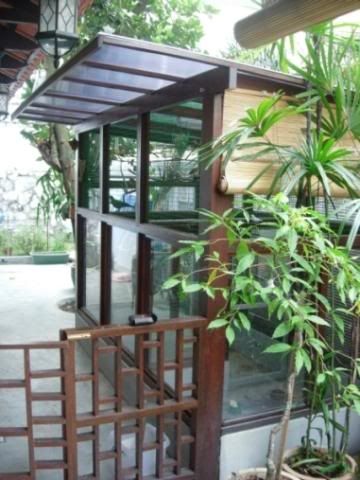
5)View from beneath the nangka tree towards the aviary and side garden.
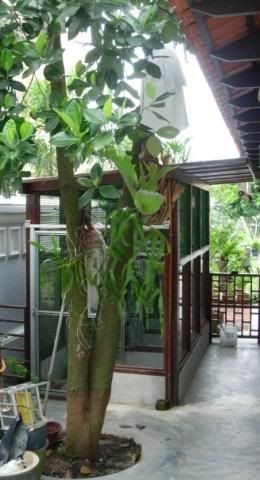
6) A Close up view from beneath the nangka tree. The dry kitchen is on my right, not in the photo, where I can sit and have tea while observing the birds. The front of the aviary faces the dry kitchen windows. No cooking is done in the dry kitchen.
Note the wood frame and concrete base margin of the aviary. The top half is epoxy coated green galvanized netting. Bottom half is glass. Roofing is polycarbonate - 'tea coloured'.
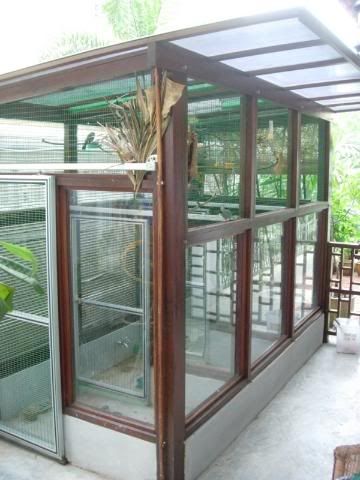
7) Main Entrance into the aviary. It is 4.5ft high. I couldn't build a safety door, the nangka tree is in the way. Thus the low entrance door, the birds will fly and perch at the top level when I open the door.

8 First Section of the aviary - The Merboks, Jambuls and Tekukur

9) Second section - The Zospterops/Mata Putehs. The green cones hung up in this section is my latest experiment to use alternative material to make nesting cups. Its not working well. I will be replacing it with traditional straw
woven baskets.

10) Third section - The Finches: Cordon Bleus, Strawberry Finches and Zebras. If you look carefully, there is a Zebra sitting in the nesting basket, you could just about see the orange beak. She is hatching 3 eggs at the moment. The Strawberry Finches are coming into their brilliant breeding plummage. Keeping my fingers crossed they will breed successfully, I have never bred Strawberry finches before.

For the technically minded forum members:
a) Median range of temperature within the aviary:
23C to 25C morning / 26C to 27C Midday to 2PM /
22C to 25C late evening & night
b) Size: Ht 7.5', W 10', D 5'
c) Wood frame is made from Keranji wood, hardwood similar to Chengal
but much cheaper
d) Concrete base margin with footing and foundation
e) Single water tap inside. Drainage concealed below
cement flooring.
f) Cement flooring - light to medium rough. Washed with acid
to reduce alkalinity post-construction.
Diet and Other Matters for the Putehs:
a) 1/3 Har liew, 2/3 commercial puteh pellets: mixed thoroughly
b) Fresh water daily (tap water, not distilled)
c) Fresh Fruits daily: Apples, oranges, Chinese Gooseberries, and 'Sengkua" (a vegetable fruit shaped like starfruit with hard exterior).
d) Special treats if available: small honey bees, bee larvae (this is tough to get).
d) Nest: Straw woven cup shaped baskets to conform with the Putehs' natural nest shape.
e) Nesting materials: coconut fibre, dried lalang
f) Aviary is cleaned alternate days.
FURTHER PHOTOS
I woke up extra early today to work on the aviary. This is what I did:
A)I swapped the green plastic net cones with straw nesting baskets in the
Puteh section of the aviary.
B) I added 2 straw baskets to the Finches section as the Strawberry Finches are getting randy, their red breeding plumage is starting to show.
Here are the photos of the work done.
1) New Baskets in the Puteh Section. There are 2 baskets. One is at the rear left corner of the photo. The other is at the front left corner. I
added the leaves around and above the baskets for additonal shade and more importantly to let the nesting bird have some peace and quiet. In the wild the Mata Putehs nest is usually built between forked branches of leafy trees. Difficult to spot in the wild.

2) Mata Putehs interested already?
There seem to be almost immediate interests in the nesting baskets. But I
doubt if they will nest soon. The weather is not right. If it rains for
a minimum of 9 days over the next 2 weeks, we might have a chance. However, I might be wrong, the Putehs had nested and bred during hot weather. They did breed in dry and hot weather in 2005.

3) The Nesting basket for the Strawberry Finches

4) The Second Nesting Basket has been taken over by the Zebras.
It was meant for the Strawberry finches, but the rascally Zebras did a
coup de tat and kicked the Stawberries out. Never mind there is the
other basket for the Srawberries which is right above it.

For Puteh brothers interested in Landscaping & Gardening
The Pond - this is the 'river mouth' where the stream ends
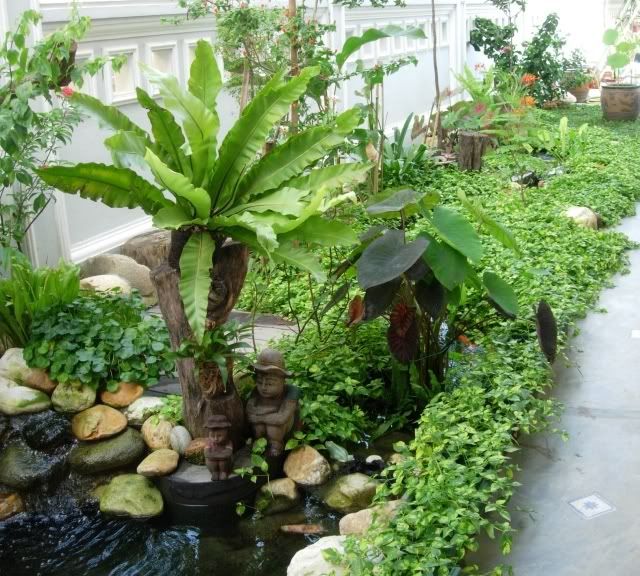
A Section of the Stream
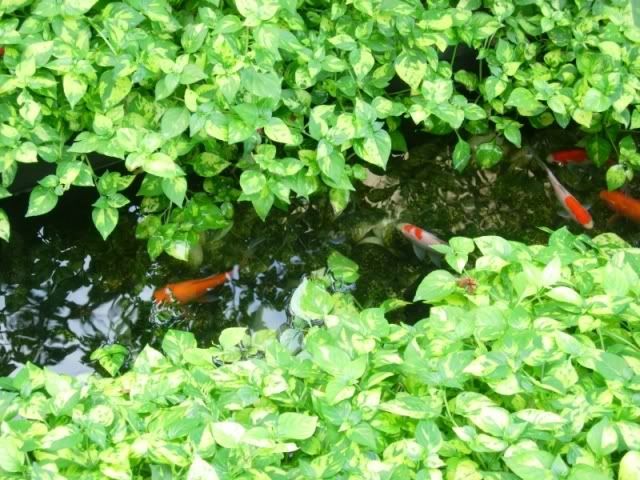
This is beautiful:)
ReplyDeleteHow much upkeep/maintenance is the stream/pond and also the remaining yard?
I've got just over 1/3 acre so I'm already at what I can maintain:( But I'd love a stream and pond if it didn't add to much additional work.. (I'm in SE Florida - tropical climate - and everything seem to grow like weed the warmest half of the year but then it need irrigation the cold months,something I don't want to addas we pay for our water-usage. (I'm not used to that in my native Norway. Where nothing grows anyway. Lol)
Thanks for sharing.
Nice aviary and very good looking birds.
Be proud!
B